If It’s Still Champagne, Is It Still Champagne? Terroir-Focus, Climate Change and Rise of New-Wave Producers Ignite Excitement For Still Winemaking in Champagne. + Champagne Clandestin ‘Elegant Champagne With a Burgundian Accent.’
If it’s still Champagne, is it still Champagne?
If the label says ‘Coteaux Champenois’, it most certainly is. This AOP, dedicated entirely to non-effervescent wine from Champagne, may be red, white or rosé, although the lion’s share is red—Bouzy rouge being the most celebrated. With a warming climate ripening grapes more consistently, Coteaux Champenois is becoming positively trendy, and this week’s wine selection is a cross-section of styles and producers across the 319 communes entitled to make wines under the Coteaux Champenois appellation.
Coteaux Champenois: A Range of Styles, A Nod to Burgundy
The tale of Champagne’s proximity to Burgundy is told in varieties; Pinot Noir and Chardonnay make up 81% of Coteaux Champenois’ plantings. Also allowed is the other Champagne staple Pinot Meunier along with less cited Arbane, Petit Meslier and the Pinot derivatives, Pinot Blanc and Pinot Gris.
Like their fizzy sisters, still wines from the region tend to be dry and light-bodied with naturally high acidity. The reds are better in warmer vintages, which is why the predominant red variety, Pinot Noir, is currently basking in the newfound heat waves of northern France. The reason that 90% of the Coteaux Champenois output is red is not necessarily because the terroir has traditionally favored Pinot Noir, but because locally grown Chardonnay has commanded a higher price when sold to Champagne houses.
But a new generation of grower/producer is taking advantage of the more consistent ripening of red grapes, including Pinot Meunier, to explore terroir and individual lieux-dits in a manner more familiar in Burgundy than Champagne. Says Simon Normand of Domaine La Borderie: “Here in the Côte des Bar we feel quite close to our Burgundian cousins. Many local young winegrowers, such as myself, studied in Burgundy rather than in Champagne.”
Also from the Coteaux Champenois is a unique still rosé called Rosé des Riceys, once a favorite of the Sun King, Louis XIV. Made in tiny quantities by only a small handful of producers, Rosé des Riceys is made through the semi-carbonic maceration of Pinot Noir grapes and can have exceptional aging potential for still rosé.
Champagne is Heating Up
You nod to recent temperature records being broken, but sometimes, harping about climate change does indeed sound like a broken record. Yet, to hear a brass-tacks anecdote is sobering: Didier Gimonnet of Pierre Gimonnet says, “When I was a child, we always harvested in October. Since 1988, we have only had two October harvests, 1991 and 2013. But we have had three August harvests in the past twenty years. There is no question that Champagne is getting warmer.”
In the short term, this is beneficial to Champagne, where ripening has traditionally been an issue. With the average temperature rising by one degree Fahrenheit since 2000, there is less and less worry that grapes will have sufficient sugar at harvest, and without the shattering acidity that makes malolactic fermentation a necessity.
But the long-term concern is obvious: With such a rapid rise in temperature, there is a fear that it might continue to arc upward at the same pace—in which case, in a worst-case scenario, the region may one day find itself out of the sparkling wine business altogether.
Drawing the Boundaries of the Champagne Region
Having been defined and delimited by laws passed in 1927, the geography of Champagne is easily explained in a paragraph, but it takes a lifetime to understand it.
Ninety-three miles east of Paris, Champagne’s production zone spreads across 319 villages and encompasses roughly 85,000 acres. 17 of those villages have a legal entitlement to Grand Cru ranking, while 42 may label their bottles ‘Premier Cru.’ Four main growing areas (Montagne de Reims, Vallée de la Marne, the Côte des Blancs and the Côte des Bar) encompass nearly 280,000 individual plots of vines, each measuring a little over one thousand square feet.
The lauded wine writer Peter Liem expands the number of sub-regions from four to seven, dividing the Vallée de la Marne into the Grand Vallée and the Vallée de la Marne; adding the Coteaux Sud d’Épernay and combining the disparate zones between the heart of Champagne and Côte de Bar into a single sub-zone.
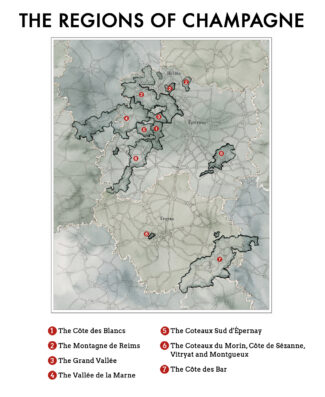
Lying beyond even Liem’s overview is a permutation of particulars; there are nearly as many micro-terroirs in Champagne as there are vineyard plots. Climate, subsoil and elevation are immutable; the talent, philosophies and techniques of the growers and producers are not. Ideally, every plot is worked according to its individual profile to establish a stamp of origin, creating unique wines that compliment or contrast when final cuvées are created.
Champagne is predominantly made up of relatively flat countryside where cereal grain is the agricultural mainstay. Gently undulating hills are higher and more pronounced in the north, near the Ardennes, and in the south, an area known as the Plateau de Langres, and the most renowned vineyards lie on the chalky hills to the southwest of Reims and around the town of Épernay. Moderately steep terrain creates ideal vineyard sites by combining the superb drainage characteristic of chalky soils with excellent sun exposure, especially on south and east facing slopes.
The Montagne de Reims: A Sea of Pinot Noir
Whether based on tradition or technical savvy, the choice of the grape variety and rootstock best suited to a specific plot is an indispensable factor in determining the ultimate success of any lieu-dit (named plot or vineyard). Whereas most Champagne is a blend of Pinot Noir and Chardonnay, both grapes make unique demands on terroir, and where one may thrive, the other may not. Sandwiched between the Marne and the Vesle Rivers, forming a broad headland of forests and thickets, the Montagne de Reims is particularly suited to the former; Pinot Noir vines carpet the western and northern flanks to form a vast semicircle extend from Louvois to Villers-Allerand, encompassing the famous villages of Bouzy and Ambonnay.
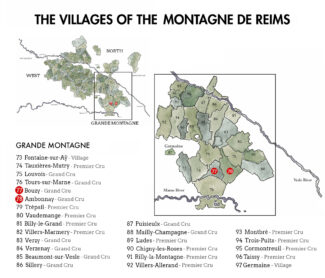
Grand Crus Bouzy and Ambonnay: The Epicenter of Pinot Noir
Like Elizabeth I and Mary Queen of Scots, the Grand Crus of Bouzy and Ambonnay co-exist in begrudging mutual respect and rivalry, and unless one figures out how to sign the other’s death warrant, this will continue for the foreseeable future. At its closest point, the distance between the two communes is less than a long drive with a golf club, and each have shored up a reputation for superlative wines from the south side of the Montagne de Reims hill.
With a population just under one thousand, Bouzy is the best known Champagne village to produce still wine (Bouzy Rouge) along with its legendary Pinot Noir-focused sparkling wine. More than nine hundred acres in Bouzy are under vine, with 87% of them Pinot Noir, 12% Chardonnay and a scant 0.2% Pinot Meunier. The most prominent Champagne houses with a Bouzy presence are Bollinger, Duval-Leroy, Moët & Chandon, Mumm, Pol Roger and Taittinger.
Nearby Ambonnay shares a nearly identical terroir with Bouzy on the south side of the Montagne de Reims hill, and is similarly appointed, although with slightly less Pinot Noir grown and a bit more Chardonnay—white grapes accounts for about 20% of the vineyards. Like Bouzy, ‘Ambonnay Rouge’ represents a small portion of wine production. Prominent Champagne houses that control Ambonnay vineyards include Duval Leroy, Moët & Chandon, Mumm, Piper Heidsieck, Pol Roger and Roederer.
Domaine Marguet
Benoît Marguet is a new breed of winemaker with an old winemaking pedigree; he is the fifth generation of Marguet to manage 20 prime acres in and around the Grand Cru Village of Ambonnay. All of his holdings are Grand Cru, many in famous lieux-dits like Les Saints Remys, Les Beurys, Les Crayères, La Grande Ruelle, Les Bermonts and Le Parc. In nearby Bouzy, he has vines in Les Loges, Les Hannepes where the average age of the vines is over 40 years, and the yield consists of 58% of Pinot Noir and 42% Chardonnay.
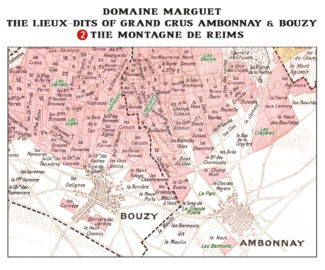
With a ‘back to the future’ view of land management, Marguet converted all of his acres to biodynamics in 2009. The vineyards are ploughed by horse and, assisted by Claude and Lydia Bourguignon, plants only with biodynamic Massale selection.
“It’s a natural approach that we carry home to the winery,” Marguet insists. “The work is done totally by gravity. Fermentation is done plot by plot in wooden vats and small barrels with long aging on its lees. No sugar is being added, and use of sulfites is virtually non-existent or kept for extremely low levels in very few cases.”
Alas, some of his best wine is only made in minuscule quantities, fewer than 3000 bottles per vintage. Still, following Lalou-Bize Leroy as his role model, Benoît Marguet is considered the most exciting natural wine producer in Champagne today.
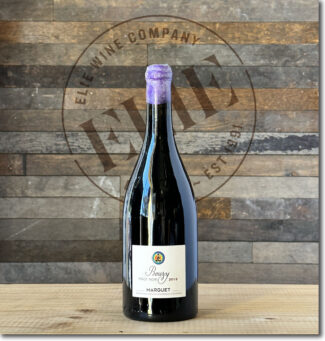 Domaine Marguet, 2018 Coteaux Champenois ‘Grand Cru Bouzy’ Red ($99)
Domaine Marguet, 2018 Coteaux Champenois ‘Grand Cru Bouzy’ Red ($99)
Thanks to south-facing slopes, Bouzy is one of only a few Champagne villages with a strong tradition of still red wines. Among the many lieux-dits, Les Loges is a Grand Cru site just below the middle of the slope to the northwest of the village, and this is the vineyard from which Marguet draws his fruit. The wine shows clean dark-cherry and blackberry with a noted spiciness on palate and substantial but ripe tannins.
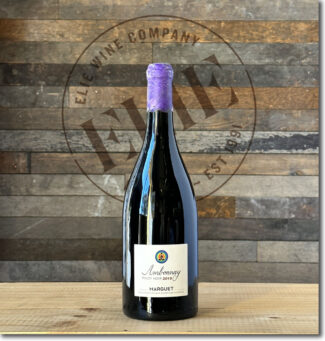 Domaine Marguet, 2018 Coteaux Champenois ‘Grand Cru Ambonnay’ Red ($99)
Domaine Marguet, 2018 Coteaux Champenois ‘Grand Cru Ambonnay’ Red ($99)
Pinot Noir requires more hang-time on the vine to fully ripen, and Marguet only produces red Coteaux Champenois in exceptionally warm years; 2018 was one of them. Les Saint Rémys is a parcel of 100% Pinot Noir located on the west side of Ambonnay near the border of Bouzy and produces a lightly-toned red wine with plum, raspberry and sloe on the nose followed by a silky, fruit-driven palate with the tug of stony minerality.
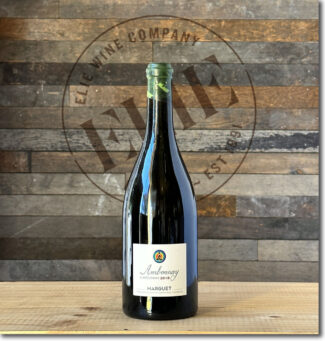 Domaine Marguet, 2018 Coteaux Champenois ‘Grand Cru Ambonnay’ White ($99)
Domaine Marguet, 2018 Coteaux Champenois ‘Grand Cru Ambonnay’ White ($99)
100% biodynamically-farmed Chardonnay from lieux-dits Les Saints Rémys and Le Parc; the nose is floral with aromas of apple white peach blossom, while the palate is concentrated with bees-wax and orange oil flavors with an intense chalkiness at its core. The Grand Cru finish is long and layered.
Domaine Gonet-Médeville
By the standards of the region, Gonet-Médeville is ‘new’ Champagne house; it was formed in 2000 by Julie and Xavier Gonet-Médeville as Xavier’s family plots were being divided up. He opted for 30 acres of high quality Premier & Grand Cru vineyards located primarily in the three villages of Bisseuil, Ambonnay, & Mesnil-sur-Oger. The Gonet-Médeville—sometimes referred to as ‘the first couple of French wines’—also have holdings in five other villages across Champagne.
Gonet-Médeville belongs to Les Artisans du Champagne, a group that prides itself on uniting vineyard with cellar. According to Julie, “Champagne Artisans expresses our total involvement in all stages the production of our Champagnes. From growing practices to the choice of plant material, from harvest to disgorging, we come in and create living Champagnes reflecting our knowledge and culture.”
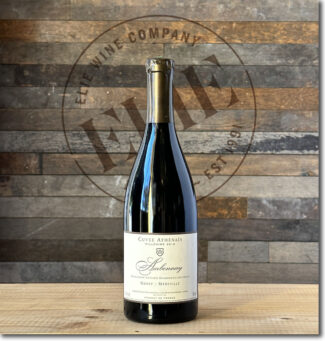 Domaine Gonet-Médeville ‘Cuvée Athénaïs’, 2018 Coteaux-Champenois ‘Grand Cru Ambonnay’ Red ($99)
Domaine Gonet-Médeville ‘Cuvée Athénaïs’, 2018 Coteaux-Champenois ‘Grand Cru Ambonnay’ Red ($99)
From a one-acre parcel of well-drained, limestone and chalky soil with vines nearly a century old; the wine reflects Xavier Gonet-Médeville’s desire to express his wines in fully ripened grapes. Hypnotically-dense and strawberry-tinged, the barrel-fermented Pinot Noir offers textbook Pinot fruit intertwined with some spicy flavors. Silky textured, pure and intense on the palate, with fine tannins, finesse and purity.
Domaine André Clouet
The Clouet family traces its Bouzy roots to 1492 and at one time was the official printmakers for the court of King Louis XV; the classically pretty labels that grace their Champagne bottles today pay homage to their aesthetic history. Clouet grapes are sourced exclusively from 20 acres of coveted mid-slope vineyards in the Grand Cru villages of Bouzy and Ambonnay.
“Our standing comes with significance,” Jean-François acknowledges. “In keeping, we strive to continually improve upon the estate and wines by drawing from its past as well as implementing changes that ultimately improve the quality of his wines. We begin with an advantage—our Grand Cru vineyards are situated in the coveted middle slopes of Ambonnay and Bouzy—but this still requires the vigilance of stewardship.”
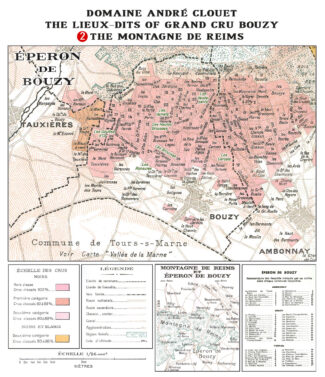
Clouet produces a full range of Champagnes, including most famously the glorious Cuvée 1911, which is comprised of 100% Pinot Noir from Clouet’s ten best lieux-dits in Bouzy; the production of each successive release is limited to 1911 bottles.
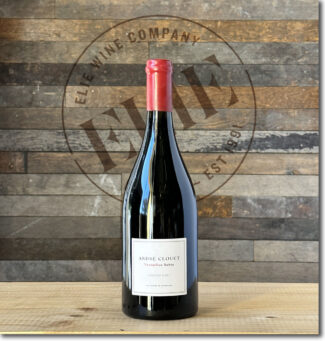 Domaine André Clouet ‘Versailles Rubis’, 2015 Coteaux Champenois ‘Grand Cru Bouzy’ Red ($108)
Domaine André Clouet ‘Versailles Rubis’, 2015 Coteaux Champenois ‘Grand Cru Bouzy’ Red ($108)
Single-vineyard Pinot Noir from the warmest year Jean-François had ever seen in Bouzy, making it the ideal opportunity for his Coteaux Champenois debut. It displays the understated fragrance reminiscent of Chambolle, with red cherry, beet root, pink pepper behind Champagne acidity and fine chalk minerality.
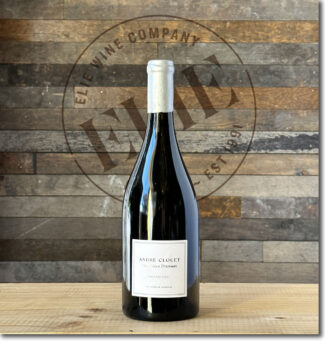 Domaine André Clouet ‘Versailles Diamant’, 2015 Coteaux Champenois ‘Bouzy Grand Cru’ Blanc ($108)
Domaine André Clouet ‘Versailles Diamant’, 2015 Coteaux Champenois ‘Bouzy Grand Cru’ Blanc ($108)
A single-vineyard Chardonnay vinified in traditional Burgundian style and barrel-aged for 20 months before bottling. The cuvée exemplifies the exuberance and tension of a warming terroir, displaying lime white peach accented by bergamot and the soft vanilla imparted by the oak.
Domaine Paul Bara
Champagne Paul Bara likes to think of itself as synonymous with the village of Bouzy. With 170 years of history under its wire muselet, multiple generations of the family have crafted celebrated Champagnes from the village’s most heralded south-facing slopes, of which they now control 26 acres.
The key to Bouzy’s heralded terroir lies in its deep, chalky subsoil which imparts intense expression of fruit and great mineral complexity to the wines; the key to this domain’s greatness is the innate respect the current generation of Bara shows for the longevity and timeless quality of the Bara’s classic style.
This is embodied and perpetuated in Chantale, Paul Bara’s daughter, who took over the estate on his retirement and today crafts wine by hand using low-yielding vines that ensures both the maturity of the fruit and the potential for prolonged bottle aging.
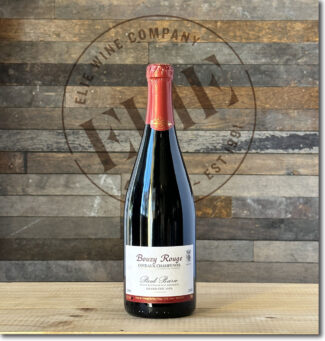 Domaine Paul Bara, 2008 Coteaux Champenois ‘Grand Cru Bouzy’ Red ($110)
Domaine Paul Bara, 2008 Coteaux Champenois ‘Grand Cru Bouzy’ Red ($110)
Made from Grand Cru Pinot Noir vines more than 50 years old, grown on clay/limestone in a Grand Cru plot of around seven acres. Production relies on hand-sorted, individually chosen grapes; it is vinified entirely in steel tanks, preserving crushed-berry freshness without oak to mellow the edges and has become a reference point for Coteaux Champenois red wine.
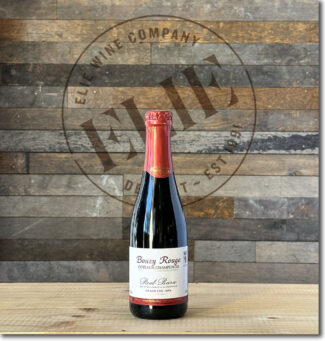 Domaine Paul Bara, 2008 Coteaux Champenois ‘Grand Cru Bouzy’ Red ($58) 375 ml
Domaine Paul Bara, 2008 Coteaux Champenois ‘Grand Cru Bouzy’ Red ($58) 375 ml
This half-bottle will have matured more quickly than the 750 ml, and is likely reaching its prime.
The Côte des Blancs: White Soils, White Grapes
‘Blancs’ means ‘whites’ of course, and in Champagne, white means Chardonnay… and the color of the superlative Cretaceous chalk that stretches south from Épernay for about a dozen miles. Along the eastern edge of Côte des Blancs’ limestone capped plateau, the midsection of the slope is known as the ‘coeur de terroir’, and in this heartland, the best Chardonnay is grown.
An abundance of chalk and very little topsoil is the primary factor that results in Côte des Blancs’ signature wines, filled with stony elegance and pronounced minerality. The most famous Grand Cru communes within the greater appellation display their own hallmark qualities, variations on this theme. Billecart-Salmon’s chef de cave François Domi draws grapes from named villages and lieux-dits to assemble wines with specific profiles: “Cramant is fabulous of is complexity and for its contrast of body and liveliness. Les Mesnil has strength and requires a lot of time to mature; Chouilly gives mineral and citrus with exotically-fresh tropical notes like pineapple.”
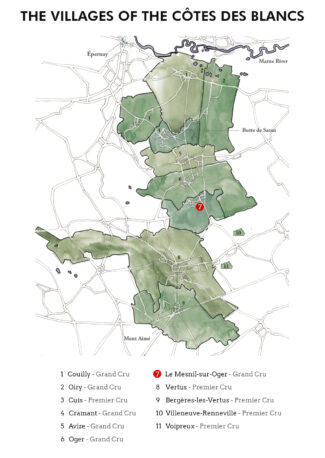
Divided into north and south, experts find the wines from the northernmost villages tend to be richer and marked with a certain girth while those made farther south have a striking salinity and show a built-in tension that comes alive with a bit of bottle age.
Louis Roederer
241 years of existence and 241 hectares of vines; today, the Louis Roederer House is headed by Frédéric Rouzaud, who represents its seventh generation of the same family to rule the Roederer roost. Exclusively drawn from Grand and Premier Cru vineyards in the Marne Valley, the Reims Mountain and Côte des Blancs, Louis Roederer is a true mosaic of terroirs with 410 individually tended plots to reflect the diversity of Champagne soils.
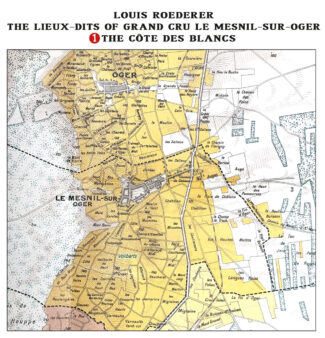
Cellar Master Jean-Baptiste Lécaillon cultivates a unique and distinctive style by exploiting the best qualities from each of these plots and treats them in the cellar with the same attention of individuality:
“Each parcel is pressed and vinified separately to guarantee their traceability and to bring out their purest expression of the terroir; fermentation takes places in over 450 small stainless-steel tanks, each containing a single vineyard parcel.”
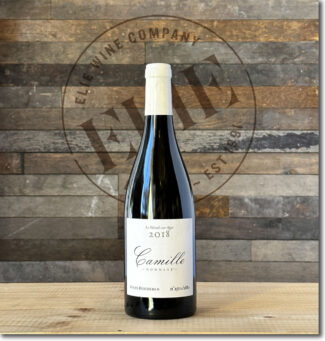 Louis Roederer ‘Camille Hommage’, 2018 Coteaux Champenois ‘Grand Cru Le Mesnil-sur-Oger’ White ($198)
Louis Roederer ‘Camille Hommage’, 2018 Coteaux Champenois ‘Grand Cru Le Mesnil-sur-Oger’ White ($198)
From a 1.6 acre parcel in lieu-dit Volibarts, this pure Chardonnay is named in honor of Camille Olry-Roederer who helmed Louis Roederer from 1932 to 1975, the great grandmother of Louis Roederer’s CEO Frédéric Rouzaud. From vines planted in 1997, the wine unfolds with a rock salt nose reminiscent of Chablis, followed by a bouquet of Mirabelle plums, toasted almonds and linden flowers. The palate hints of tarragon and white peach and the minerality reasserts itself at the finish.
The Grande Vallée: Premier Terroir in Cru Dizy
The vineyards of Dizy are notably different from those of nearby Aÿ—the hillsides begin to curve to the west and the soils begin to pick up more clay and marl to balance the chalk.
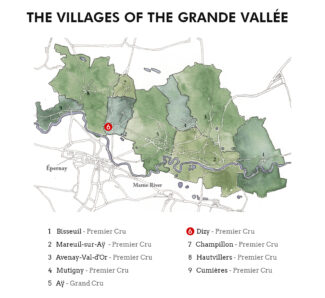
Sprawled across 437 acres and 120 owners, the vineyards in Dizy are predominantly planted on south-facing slopes, evenly mixed with Pinot Noir and Chardonnay balanced with 23% Pinot Meunier. Noted single vineyard and vineyard-designated sites include Corne Bautray (where soils are clay with a lot of gravel and chalk underneath), Les Clos, Terres Rouges and Le Léon, on the commune border between Dizy and Aÿ.
Domaine Marc Hébrart
Established in 1964, the Hébrart domain has built a reputation as one of the finest producers in the Grand Vallée. Jean-Paul Hébrart has been the head winemaker since taking over the estate’s 34 acres from his father in the mid-1990’s. He has shifted focus to highlighting the individual parcels of old vines located in estate-owned vineyards within the Grand Cru sites in Aÿ, Avize, Chouilly and Oiry as well as holdings in the Premier Crus Mareuil-sur-Aÿ, Avenay, Val d’Or and Bisseuil. Each parcel is vinified separately to better understand the terroir and blended to achieve the holy grail of Champagne houses—consistency and quality.
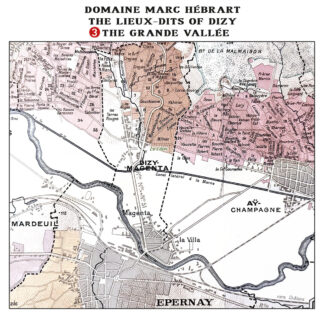
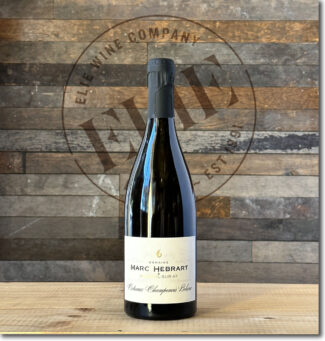 Domaine Marc Hebrart ‘Le Léon’, 2016 Coteaux Champenois ‘Premier Cru Dizy’ White ($119)
Domaine Marc Hebrart ‘Le Léon’, 2016 Coteaux Champenois ‘Premier Cru Dizy’ White ($119)
Le Léon is a historic vineyard on the border of Aÿ Grand Cru and Dizy, named for Pope Leo the Magnificent, who is said to have only accepted Aÿ made from this specific site. 100% Chardonnay, the wine is vinified in barrel without malolactic and aged for 18 months on fine lees. Graceful and expressive, it offers lemon confit, white flowers and mint on the nose with an extensive mineral-laden finish.
RECENT ARRIVAL
The wine world is a churning urn of burning trends, and what catches fire in America is not necessarily the same thing that ignites Europe: The concept of ‘grower Champagne’, for example, often carries more weight here than it does among the Champenois producers themselves. Champagne made in-house from grapes grown on the estate may wear the grower Champagne label, while the majority of Champagne houses purchase grapes as négociants and create signature blends. When a house wears ‘Domaine’ on the label, it is the former; ‘Maison’ generally represents the latter.
Between the two is the micro-négociant, who operates on a smaller scale and often produces high-quality micro-cuvées, controlling production from vineyard to bottling, and focuses on representing individual vineyard sites.
One micro-négociant estate that is capturing attention of both here and in Aube is Champagne Clandestin, a joint venture between Meursault-trained winemaker Benoît Doussot and Aube legend Bertrand Gautherot of Vouette & Sorbée.
Micro-Négociant
Champagne Clandestin
‘Elegant Champagne with a Burgundian Accent’
‘Clandestin’ means exactly what you think it does—something hidden, something to be explored. In this case, it refers to the Aube’s long-overlooked, west-facing parcels of Pinot Noir on Kimmeridgian soils as well as Chardonnay on Portlandian soils above Buxières.
These cuvées represent vineyards that have generally been eschewed in the region; southerly, easterly and southeastern-facing parcels have long been favored in the Aube because they are exposed to more sunlight during day while their western counterparts have never been fully utilized. Both Bertrand and Benoît were convinced that a longer and slower ripening and maturation process could imbue the wines with added complexity and depth. Clandestin is made from 20 acres of cooler, west-facing vineyards, which are farmed organically, certified by ECOCERT and vinified according to the exacting standards for which Vouette & Sorbée is known.
Benoît says, “After pressing, the wine is aged in French oak barrels following closely the training I received in Meursault before moving north to Champagne. This wine should appeal to purists in search of minerality, cut, and precision. Because we insist on harvesting perfectly ripe grapes, which is not generally the case in Champagne, the wines can be bottled with no dosage, giving room for the oceanic terroir to really shine through.”
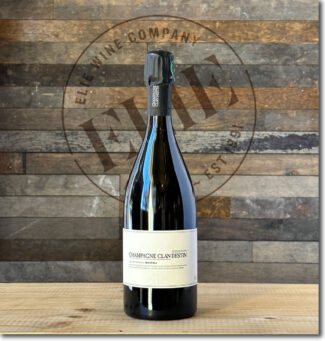 nv Champagne Clan Destin ‘Les Semblables, (BORÉAL) Côte-des-Bar Brut Nature ($73)
nv Champagne Clan Destin ‘Les Semblables, (BORÉAL) Côte-des-Bar Brut Nature ($73)
Harvest 2019. 100% Pinot Noir grown on vines between 20-35 years old, fermented and aged in French oak before aging sur latte for 15 months before being disgorged with zero dosage. Earthy aromas of wild strawberries, brioche and toast waft from the flute followed by a delicate mineral crunch. Disgorged October 1, 2021.
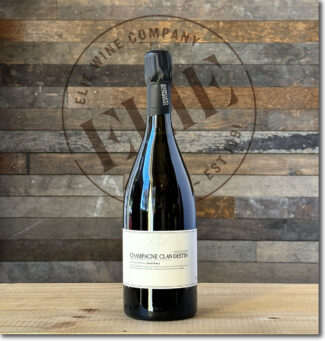 nv Champagne Clan Destin ‘Les Semblables, (AUSTRAL) ($79) Côte-des-Bar Brut Nature
nv Champagne Clan Destin ‘Les Semblables, (AUSTRAL) ($79) Côte-des-Bar Brut Nature
Harvest 2019. A Blanc de Noirs from 30-year-old Pinot Noir vines grown in calcareous Kimmeridgian soil with clay and marl. Austral ferments spontaneously with native yeasts and is then aged in 350 and 500 liter used oak barrels; disgorge and finished without dosage. The wine shows zesty acids and a creamy mousse dominated by lychee and wild strawberry. Disgorged October 1, 2021.
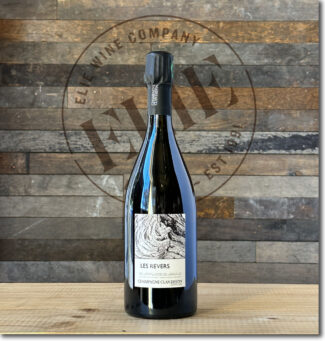 nv Champagne Clan Destin ‘Les Revers’ Côte-des-Bar Brut Nature ($110)
nv Champagne Clan Destin ‘Les Revers’ Côte-des-Bar Brut Nature ($110)
Harvest 2019. 100% Chardonnay from a single vineyard site planted on Portlandian clay. Like everything ‘Clandestin’, it is harvested by hand and fermented by natural yeasts in a French oak demi-muid. After 10 months it is bottled and aged sur latte for 15 months, and to retain the purity of the terroir, Les Revers is bottled without dosage. The wine redolent of toasted ginger, honeysuckle and orange blossom and shored by apple and pear. Disgorged October 15, 2021.
Notebook …
Single Harvest vs Vintage
In France, under Appellation d’Origine Contrôlée (AOC) rules, vintage Champagnes must be aged for three years—more than twice the required aging time for NV Champagne. The additional years on the yeast is said to add complexity and texture to the finished wine, and the price commanded by Vintage Champagne may in part be accounted for by the cellar space the wine takes up while aging.
On the other hand, a Champagne maker might prefer to release wine from a single vintage without the aging requirement; the freshness inherent in non-vintage Champagnes is one of its effervescent highlights. In this case, the wine label may announce the year, but the Champagne itself is referred to as ‘Single Harvest’ rather than ‘Vintage’.
Drawing the Boundaries of Champagne
To be Champagne is to be an aristocrat. Your origins may be humble and your feet may be in the dirt; your hands are scarred from pruning and your back aches from moving barrels. But your head is always in the stars.
As such, the struggle to preserve its identity has been at the heart of Champagne’s self-confidence. Although the Champagne controlled designation of origin (AOC) wasn’t recognized until 1936, defense of the designation by its producers goes back much further. Since the first bubble burst in the first glass of sparkling wine in Hautvillers Abbey, producers in Champagne have maintained that their terroirs are unique to the region and any other wine that bears the name is a pretender to their effervescent throne.
The INAO defines the concept like this: “An AOP area is born of an alliance between the natural environment and human ingenuity. From that alliance comes an AOP product with unique, inimitable characteristics, a product so different that it complements rather than competes with other products, possessing a particular identity that adds further value.”
In 1927, the viticultural boundaries of Champagne were legally defined and split into five wine-producing districts: The Aube, Côte des Blancs, Côte de Sézanne, Montagne de Reims, and Vallée de la Marne. The CIVC (Comité Interprofessionnel du vin de Champagne), formed in 1941, decreed that everyone who wanted to plant vines and grow grapes to be used in the creation of Champagne had to be registered, and if you didn’t register back then, there is no out, even now. Originally, grape growing was not a profitable business and was an afterthought meant to utilize chalky slopes where grain would not grow. As a result, many farmers at that time did not register, and today, a tour along the Route Touristique de Champagne, you’ll come across unregistered fields that lie fallow between two registered vineyards.
… Yet another reason why this tiny slice of northern France, a mere 132 square miles, remains both elite and precious.
- - -
Posted on 2023.08.19 in Coteaux Champenois, France, Champagne
Featured Wines
- Notebook: A’Boudt Town
- Saturday Sips Wines
- Saturday Sips Review Club
- The Champagne Society
- Wine-Aid Packages
Wine Regions
Grape Varieties
Albarino, Albarín Blanco, Albarín Tinto, Albillo, Aleatico, Aligote, Arbanne, Aubun, Barbarossa, barbera, Biancu Gentile, bourboulenc, Cabernet Franc, Caino, Caladoc, Calvi, Carcajolu-Neru, Carignan, Chablis, Chardonnay, Chasselas, Cinsault, Clairette, Corvina, Counoise, Dolcetto, Erbamat, Ferrol, Frappato, Friulano, Fromenteau, Gamay, Garnacha, Garnacha Tintorera, Gewurztraminer, Graciano, Grenache, Grenache Blanc, Groppello, Juan Garcia, Lambrusco, Loureira, Macabeo, Macabou, Malbec, Malvasia, Malvasia Nera, Marcelan, Marsanne, Marselan, Marzemino, Mondeuse, Montanaccia, Montònega, Morescola, Morescono, Moscatell, Muscat, Natural, Niellucciu, Parellada, Patrimonio, Pedro Ximénez, Petit Meslier, Petit Verdot, Pineau d'Aunis, Pinot Blanc, Pinot Gris, Pinot Meunier, Pinot Noir, Pouilly Fuisse, Pouilly Loche, Poulsard, Prieto Picudo, Riesling, Rondinella, Rose, Rousanne, Roussanne, Sagrantino, Sauvignon Blanc, Savignin, Sciacarellu, Semillon, Souson, Sparkling, Sumoll, Sylvaner, Syrah, Tannat, Tempranillo, Trebbiano, Trebbiano Valtenesi, Treixadura, Trousseau, Ugni Blanc, vaccarèse, Verdicchio, Vermentino, Xarel-loWines & Events by Date
- July 2024
- June 2024
- May 2024
- April 2024
- March 2024
- February 2024
- January 2024
- December 2023
- November 2023
- October 2023
- September 2023
- August 2023
- July 2023
- June 2023
- May 2023
- April 2023
- March 2023
- February 2023
- January 2023
- December 2022
- November 2022
- October 2022
- September 2022
- August 2022
- July 2022
- June 2022
- May 2022
- April 2022
- March 2022
- February 2022
- January 2022
- December 2021
- November 2021
- October 2021
- September 2021
- August 2021
- July 2021
- June 2021
- May 2021
- April 2021
- March 2021
- February 2021
- January 2021
- December 2020
- November 2020
- October 2020
- September 2020
- August 2020
- July 2020
- June 2020
- May 2020
- April 2020
- March 2020
- February 2020
- January 2020
- December 2019
- November 2019
- October 2019
- September 2019
- August 2019
- July 2019
- June 2019
- May 2019
- April 2019
- March 2019
- February 2019
- January 2019
- December 2018
- November 2018
- October 2018
- September 2018
- August 2018
- July 2018
- June 2018
- May 2018
- April 2018
- March 2018
- February 2018
- January 2018
- December 2017
- November 2017
- October 2017
- September 2017
- August 2017
- July 2017
- June 2017
- May 2017
- April 2017
- March 2017
- February 2017
- January 2017
- December 2016
- November 2016
- October 2016
- September 2016
- August 2016
- July 2016
- June 2016
- May 2016
- April 2016
- March 2016
- February 2016
- January 2016
- December 2015
- November 2015
- October 2015
- September 2015
- August 2015
- July 2015
- June 2015
- May 2015
- April 2015
- March 2015
- February 2015
- January 2015
- December 2014
- November 2014
- October 2014
- September 2014
- August 2014
- July 2014
- June 2014
- April 2014
- March 2014
- February 2014
- January 2014
- December 2013
- November 2013
- October 2013
- September 2013
- August 2013
- July 2013
- June 2013
- May 2013
- April 2013
- March 2013
- February 2013
- January 2013
- December 2012
- November 2012
- October 2012
Search



